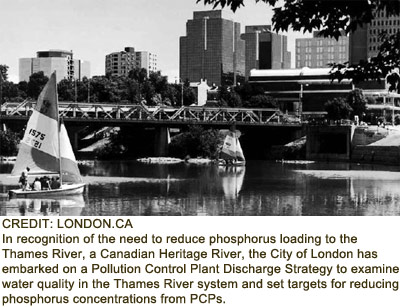Preserving a London landmark for future generations

As beautiful as she is infected, the Thames River is currently accumulating a large amount of algae due to poor treatment.
Phosphorous itself is not toxic, in fact it is vital for human, plant and animal life; however, an excess amount causes many problems in the river, such as an overabundance of plant growth, algae blooms and the death of certain fish and other aquatic species.
London's sewage treatment plant workers are doing everything they can to remove phosphorous from sewage before letting it into the Thames River. John Fitzgerald, division manager, said the treatment plant removes approximately 90 per cent of the phosphorous that is put in the sewer system.
Fitzgerald explained the process by which the plant removes phosphorous. "We use chemical addition of iron salts or aluminum sulphate and it precipitates the phosphorous out in our primary sludge. It's then collected and dealt with throughout (the) sludge system. Also, in the biological process and the reactor, the bacteria that's decomposing the organics also uses phosphorous as its own cell structure and holds it as one of its primary building blocks."
London has a variation of combined sewers and storm sewers. Although combined sewers are not ideal for sewage bypass, they are helpful in controlling the amount of phosphorous entering the Thames.
Combined sewers collect rain water and sewage and it all comes directly to the plant. This is beneficial in the treatment of phosphorous because a lot of phosphorous comes from lawn fertilizers which are washed away with rain and into the sewers.
In the new 20-year plan proposed by the London sewage treatment plant, the goal is to completely get rid of combined sewers and have only storm sewers and sanitary sewers. This will increase the amount of phosphorous entering the river because "we don't treat that. We don't have the ability to treat that because we don't have a plant that treats storm water on existing systems," said Fitzgerald. However, he added that "In new subdivisions, there are storm water management ponds and those ponds are put in there to do some primary treatment and to reduce sediment that might wash to the river."
To every problem, there is a silver lining. Phosphorous is not a bio-accumulator, therefore it will flush out of the system. This is only possible, however, if we reduce the amount we put in it. The ban of phosphates in laundry detergents was established in 1972, but we still can do more.
Every homeowner or apartmentdweller can reduce phosphorous loading to the river by buying phosphate-free soaps and cleaners. Homeowners can fertilize lawns using compost. Everyone can conserve water in and out of the house — for example, don't flush twice, use low flow shower heads and low flow toilets. Fitzgerald gave a tip on how to wash your car while disposing of minimal phosphates: "Wash your car using no phosphorous or low phosphorous soap right on your lawn. It gives the water a chance to get into the soil. The soap won't hurt the grass, and actually it helps get rid of some of the pests and makes you save water because you're getting a double bang for your buck."
As the city's most beautiful natural landmark and one of the most biologically diverse rivers in Ontario, more needs to be done to preserve it. Everyone is responsible and everyone can help fix it.













